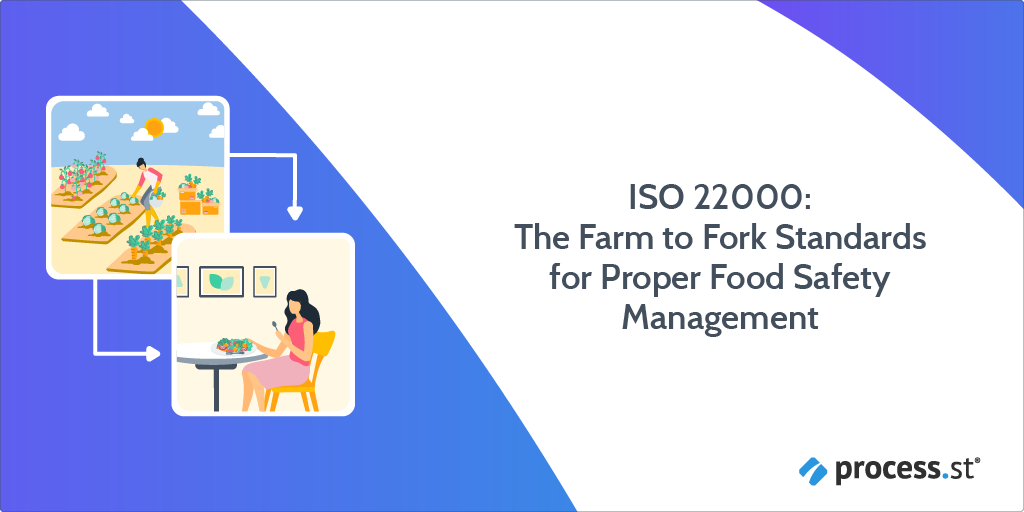
I didn’t expect to get ill the last time I ordered food via UberEats.
Was it because of the rib eye steak? How the cook prepared it? Or how the steak was transported to the restaurant from the producer?
I don’t know.
What I do know, though, is that the CDC estimates 48 million people each year get sick from foodborne illness.
No matter your role in the food supply chain – whether you’re a primary producer, a storage operator, or a subcontractor to a food outlet – a food safety management system is necessary. Otherwise, you’re exposing people to illnesses that could potentially be life-threatening. Even if the illness is fleeting, the long-term result of a consumer’s sickness will result in your brand being tarnished.
Luckily, ISO 22000 can help you create and sustain a solid food safety management system.
In this post, I’ll discuss what ISO 22000 is in more detail, its requirements, its benefits, and why food safety management systems are just so important. Plus, I’ll explain how Process Street can help you gain ISO 22000 certification!
Read through the following sections to get clued up:
- What is ISO 22000?
- The importance of a food safety management system
- ISO 22000 requirements
- The benefits of ISO 22000
- Use Process Street to gain ISO 22000 certification!
Hungry to learn more?
It’s time to dig in!
What is ISO 22000?

ISO 22000 is a standard established by the International Organization for Standardization. It concerns food safety and helps those working in the food industry to ensure they’re minimizing food risks. This is achieved via a quality management systems approach.
To gain ISO 22000 certification, a food safety management system needs to be properly built, maintained, and sustained. This means documenting all the individual processes that, as a whole, make up the food safety management system and then having all employees follow those processes.
What’s also worth noting is that ISO 22000 is a derivative of ISO 9000. Simply put, ISO 9000 is a family of quality management system standards. You’ll see Process Street‘s ISO 9000 Structure Template below, which you can then use to build out the ISO 22000 processes and procedures yourself!
Click here to get the ISO 9000 Structure Template!
For a little more on ISO 22000, check out the video below.
The importance of a food safety management system

So, ISO 22000 is all about the development of a food safety management system…
But what, exactly, is a food safety management system and why is it so important? What makes a food safety management system so worthwhile that a whole ISO standard has been made for it?
I’ll start at the top.
To comply with FDA guidelines, all food processors must have and follow HACCP (hazard analysis critical control point) guidelines, in addition to having CAPAs (corrective actions and preventative actions) in place.
However, following these guidelines isn’t enough. There are so many other areas and instances where food can become prone to contamination.
With a food safety management system – which is an all-enveloping system that considers the entire journey of food, from farm to fork – contamination can be stopped in its tracks.
As already briefly mentioned, a food safety management system is essentially just a collection of processes and procedures related to food safety. A food safety management system can be self-defined and self-governed, but whether it actually works and holds up to internationally-recognized standards is a different matter.
A poor food safety management system – or simply not having one in place – can incur the following costs, detailed by Adam Marsh at Ledge Inc.:
- Loss of customers and sales.
- Negative media exposure
- Loss of reputation ⬇️
- Lawsuits and legal fees ⚖️
- Increased insurance premiums
- Staff missing work
- Lower staff morale
- Staff retraining costs
– Adam Marsh, Why a Food Safety Management System Is Important
No company wants to make others ill, nor would they want to rack up thousands of dollars in fees due to bad food safety practices.
To ensure none of the negatives happen, a food safety management system – that’s been built and sustained alongside ISO 22000 standards – is one of the best routes to go down as a company in the food industry.
I wrote “one of the best” because there are other standards and certifications related to food safety and food safety systems, such as FSSC 22000. But ISO 22000 is, arguably, one of the comparatively simpler ones to follow and achieve certification with.
Next up, the requirements of the ISO 22000 standard.
ISO 22000 requirements

Considering that ISO 22000 is a standard, there are numerous requirements that make up the standard as a whole.
To use an analogy or two, just as a handful of ingredients eventually results in a meal, and a collection of processes results in a system, the same sentiment applies to ISO standards.
“But what are the requirements of ISO 22000?”, I hear you ask.
In short, the requirements are based on 4 main areas:
- Prerequiste programs (PRPs)
- HACCP principles
- Interactive communication
- System management
Seeing as it can take months to fully create and implement a food safety management system that adheres to the ISO 22000 standard, you’d be right in thinking that there are a lot of requirements to abide by within these 4 main areas.
For a more detailed overview of the requirements involved, Registrar Corp has compiled this nifty list:
- Having an overall Food Safety Policy for your organization, developed by top management
- Setting objectives that will drive your companies efforts to comply with this policy
- Planning and designing a management system and documenting the system
- Maintaining records of the performance of the system
- Establishing a group of qualified individuals to make up a Food Safety Team
- Defining communication procedures to ensure effective communication with important contacts outside the company (regulatory, customers, suppliers and others) and for effective internal communication
- Having an emergency plan
- Holding management review meetings to evaluate the performance of the FSMS
- Providing adequate resources for the effective operation of the FSMS including appropriately trained and qualified personnel, sufficient infrastructure and appropriate work environment to ensure food safety
- Following HACCP principles
- Establishing a traceability system for identification of product
- Establishing a corrective action system and control of nonconforming product
- Maintaining a documented procedure for handling withdrawal of product
- Controlling monitoring and measuring devices
- Establishing and maintaining and internal audit program
- Continually updating and improving the FSMS
Seem impossible? Too confusing, too complex? Like it’ll take years upon years to do it?
From an initial glance, I can understand any feelings of apprehension and uncertainty.
However, the reality of the situation is that creating a food safety management system that complies with ISO 22000 isn’t as daunting as it may first appear. Especially as it’s a company-wide effort, where multiple minds will come together to build, implement, and sustain the food safety management system in question.
In terms of time, sure, it won’t be the quickest of projects, but the long-term payoff – both literally and metaphorically – is worth it.
Here’s why.
The benefits of ISO 22000

I wouldn’t have written this post if ISO 22000 didn’t bring about some kind of benefit for businesses.
In fact, it’s fair to say there are plenty of rewards to be reaped by complying with ISO 22000’s requirements and getting certification.
By doing so, you’ll be able to:
- Take control of your processes and procedures.
- Document important processes and procedures.
- Improve customer & client satisfaction.
- Encourage others locally and internationally to work with you.
- Eliminate food risks.
To create a food safety management system that is ISO 22000-approved, you’re first going to need to build out, document, and implement integral food safety processes. This invariably means reassessing, rebuilding, and creating new important processes and procedures from scratch, giving you complete control over all your processes and procedures!
Documenting business processes is a massive win in itself. By documenting processes, it makes recuring tasks simple to follow (especially if they’ve been documented with digital software), easy to repeat, and any new hires can instantly know what to do and how. Plus, by documenting processes, you can keep human error at bay. Here’s to keeping organized.
Do you know what keeps customers satisfied? I’ll tell you: Consuming tasty produce or goods without getting ill afterward. And without a robust food safety management system, there’s no guarantee you can stop that from happening. Similarly, from a client’s perspective, they’ll be more inclined to work and/or buy from you if you can guarantee that consumers won’t get foodborne illnesses.
ISO 22000 is an internationally-recognized food safety standard. So, if a retailer from let’s say, France, notices that you, a U.S.-based producer, are ISO 22000 certified, they’ll be more interested in working and collaborating with you than with a company who isn’t. Having ISO 22000 certification is like having a stamp of approval.
At its core, ISO 22000 is all about making sure the way your business handles food doesn’t pose a threat to consumers. By actively following and abiding by ISO 22000’s guidelines, you’ll rest assured knowing you’ve done everything in your power to eliminate food risks.
I know what you’re thinking: It’s an impressive list of benefits.
Luckily, it’s only a matter of time before you can clinch these rewards yourself – with the right business software, of course.
By “right business software”, I’m specifically referring to Process Street’s state-of-the-art BPM software.
Here’s how it’ll bolster and quicken your journey of creating and maintaining a robust food safety system, and then achieving ISO 22000 certification. ⬇️
Use Process Street to gain ISO 22000 certification!
Process Street is superpowered checklists.
When it comes to ISO 22000 in particular, you can utilize Process Street in a whole host of ways.
Firstly, seeing as the food safety management system itself is made up of a vast collection of processes, you can document all those processes as templates. Then, whenever an employee or staff member needs to follow an integral process, they can follow it to the T via a checklist.
Basically, you can use Process Street to house and then follow every single one of your food safety management system processes!
You can even use our ISO 9000 Structure Template to help you build out the ISO 22000 processes and procedures themselves.
Click here to get the ISO 9000 Structure Template!
But there are other ways you can use Process Street in this context, too.
For instance, you can use our IS0 19011 Management Systems Audit Checklist to internally audit your system before it’s audited by an external body.
Click here to get the IS0 19011 Management Systems Audit Checklist!
All you’ve got to do to add these free checklist templates to your dashboard – or make your own from scratch – is to sign up.
Now, if you’re wondering what makes our checklists superpowered, it’s our workflow automation features.
They include (but aren’t limited to):
- Stop tasks ✋
- Conditional logic
- Dynamic due dates ⏱
- Task permissions
- Task assignments
- Role assignments
- Embed widget
- Webhooks
- Approvals ✅
In a nutshell, these features will help you and the rest of your team collaborate like pros, making obtaining ISO 22000 certification that much easier – not to mention faster.
For a deep dive into how some of these features work, watch the following webinar.
That’s it.
With everything supplied in this post – information on ISO 22000, instructions on how to sign up to the nifty checklist app known as Process Street, the free checklist templates – you’ve got everything you need to start your journey.
Here’s to having a solid food safety management system and becoming ISO 22000 certified.
Do you have experience with ISO 22000 or food safety management systems? If so, please share any insider tips and tricks you have with the Process Street community. You can do so by writing a comment below!







 Workflows
Workflows Forms
Forms Data Sets
Data Sets Pages
Pages Process AI
Process AI Automations
Automations Analytics
Analytics Apps
Apps Integrations
Integrations
 Property management
Property management
 Human resources
Human resources
 Customer management
Customer management
 Information technology
Information technology



Thom James Carter
Thom is one of Process Street’s content writers. He’s also contributed tech-related writing to The New Statesman, Insider, Atlassian, G2, The Content Marketing Institute, and more. Follow him on Twitter @thomjamescarter.